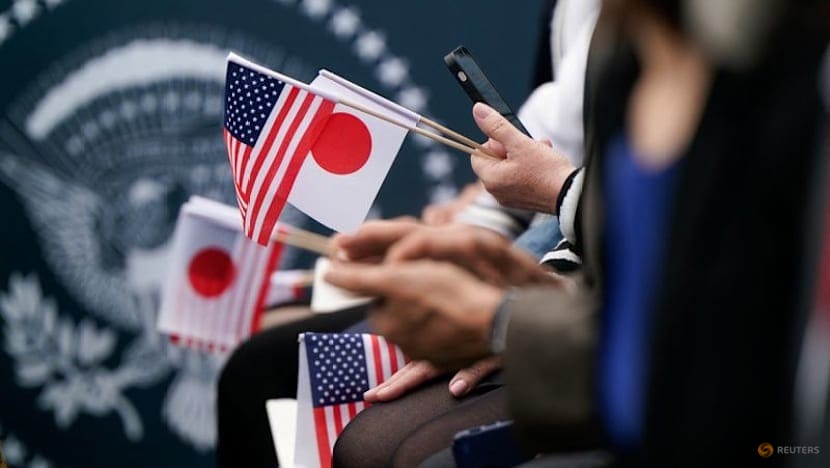Japan says 'no discrepancies' with US on investment

People hold Japan and US flags during an official White House State Arrival ceremony on the South Lawn of the White House in Washington, DC, US, on Apr 10, 2024. (File photo: REUTERS/Elizabeth Frantz)
TOKYO: Japan's tariff envoy said on Wednesday (Oct 1) there were "no discrepancies" with the United States on the US$550 billion of mooted investments by Tokyo as part of their recent trade agreement.
Under the terms of the US-Japan deal lowering threatened tariffs, Tokyo will invest the money in the United States, according to the White House.
South Korea is also on the hook for US$350 billion of investments under a last-minute agreement struck in July reducing looming levies.
US President Donald Trump has said both countries will provide this "signing bonus" upfront.
A US-Japan memorandum of understanding (MoU) made no mention of immediate payments, saying that they would be made "from time to time".
The MoU also stipulated that Tokyo would provide the necessary funding within 45 days of Washington selecting an investment area, or face higher tariffs.
But Ryosei Akazawa, who negotiated the deal for Japan, has said that only 1 to 2 per cent of the US$550 billion will be actual investment, with the rest loans and loan guarantees.
Washington "isn't particularly interested in the distinction between investments, loans, and loan guarantees" he said Wednesday.
"I do not believe there are any discrepancies. In order to avoid discrepancies, the US proposed the memorandum of understanding and Japan responded to that. And it was signed," he told reporters.
"A memorandum of understanding is not a treaty, nor is it legally binding. An MoU is an administrative document that lays out the common understanding, which I believe we have on both ends," he added.
MISSION IMPOSSIBLE
Washington agreed in August to reduce across-the-board tariffs from 25 per cent to 15 per cent on South Korea – as it did for Japan – though the higher levies were kept on certain products such as steel.
But the reduction has yet to take effect.
At the time, Trump said South Korea would provide US$350 billion for investments and purchase US$100 billion in liquefied natural gas or other energy products.
According to government sources in Seoul, the plan initially included direct investment, loans and guarantees, with South Korea trying to cap direct investment at around 5 per cent and cover most of its commitments through guarantees.
Washington, however, is pushing for a larger share of direct equity investment in sectors of its choosing.
South Korea's national security adviser Wi Sung-lac told a briefing on Monday that providing US$350 billion in cash was "impossible".
Seoul has also requested a currency swap to help reduce foreign exchange market volatility.
Finance Minister Koo Yun-cheol also met US Treasury Secretary Scott Bessent last week to discuss the package and foreign currency concerns.
Koo told reporters that "consultations have been completed and an announcement will be made soon".
"Our country's foreign exchange reserves are at the level of US$410 billion, which is insufficient to defend against the rise in the exchange rate caused by US$350 billion investment in the US," Kim Dae-jong, professor of business at Sejong University, told AFP.
"The government must explain well to the United States that even though Korea is an allied country, it is difficult to be asked for excessive direct investment and tariff burdens," Kim said.















